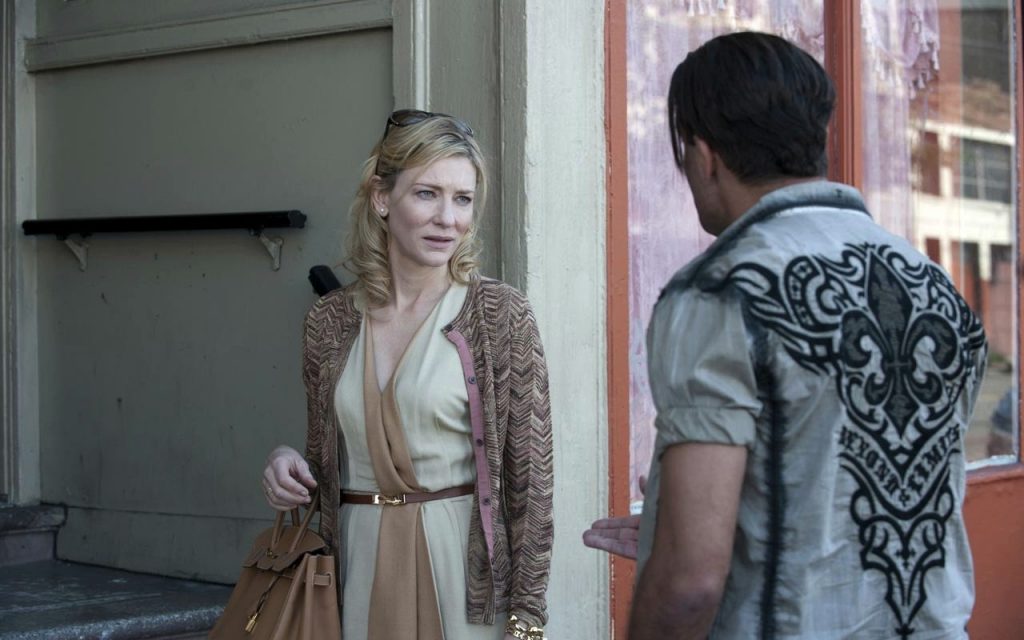Review: Blue Jasmine (2013)
Blue Jasmine shows Woody Allen trying something new. It’s not pure drama nor is it straight comedy. It has funny parts but it’s anchored by a seething, unhinged performance by Cate Blanchett. It may not be as delightful as 2011’s Midnight in Paris (few of Allen’s films are), but it’s trying to make a social statement more complex than merely saying nostalgia can be dangerous.
Blue Jasmine is Allen’s 43rd film as director, and it shows quite clearly that he isn’t slowing down or running out of ideas. Of course, it contains the same Allen tropes that anyone who’s seen a few of his films will recognize: pseudo-intellectuals, assumptions that life in upper-middle class New York is the epitome of civilization, characters who take copious amounts of Xanax. But it also seems to be more blatantly critical of many of these familiar tropes. Instead of merely making fun of rich New York yuppies, Allen seems to be consciously equating their decadent lifestyle with mental delusion.
The film follows Cate Blanchett’s Jasmine, a New York socialite recovering from a nervous breakdown triggered by the arrest of her philandering millionaire husband (Alec Baldwin). Stripped of her money, her home and shunned by her friends, she moves to San Francisco to stay with her blue-collar sister, Ginger (Sally Hawkins). There she struggles to handle a job as a secretary at a dental office, meet suitable men, and maintain a grip on her sanity.
The film is a showcase for Blanchett’s performance. From arguing with Ginger’s tough-guy boyfriend Chili (an impressive Bobby Cannavale) to flashback’s of her luxurious former life, the film is meant to show just how good an actress Cate Blanchett is. It’s rare for a Woody Allen film to have such a towering performance at its centre. Most of his films are ensemble pieces — even Blue Jasmine lends much of its screen time to the supporting players. But the film is squarely Jasmine’s, and Blanchett makes the most of it. A depressing dinner where Jasmine confesses her problems to her two portly nephews is a particular standout. Blanchett’s sunken face, smeared makeup, eyes retreating into madness, and mouth snarling at perceived injustices against her, show just how distraught a character Jasmine is.
It’s this kind of hyperbolic performance, and similarity of plot, that links Blue Jasmine to A Streetcar Named Desire, the famous Tennessee Williams play following a woman on the brink of madness while convalescing with her sister. While A Streetcar Named Desire is a southern melodrama of the highest order, full of raging emotions and simmering sexuality (quite different than Blue Jasmine) the comparison does bring to light a few of Blue Jasmine’s biggest issues.
Although tethered to the real world with its portrayal of financial crime and American opulence, the notion of Jasmine’s madness is highly figurative. Blue Jasmine isn’t a melodrama, but Jasmine herself seems to be a theatrical character transposed into a real world setting. Perhaps Allen intended this as a comment on how fake people like Jasmine are, but the result is often jarring in some of the film’s scenes.
Allen also lets the film meander when it should remain tightly focused on Jasmine. I’ve often heard that Allen writes his films by pulling out a punch of random ideas from his cabinet and shoehorning them all together into one script. You can feel that here, as many of Blue Jasmine’s developments, particular an affair Hawkin’s Ginger has with a romantic stranger she meets at a party (played by Louis C.K.), are underwhelming and seem stranded in the script.
Blue Jasmine is a more intense and accusatory film that many of Allen’s in the past. It cannot bring itself to fully embrace the melodramatic emotion fueling Blanchett’s main character, but it is well acted, funny, and occasionally insightful in its portrayal of class and delusion in contemporary America.
Blue Jasmine (2013, USA)
Written and directed by Woody Allen; starring Cate Blanchett, Alec Baldwin, Louis C.K., Bobby Cannavale, Andrew Dice Clay, Sally Hawkins, Peter Sarsgaard, Michael Stulhbarg.
This article was originally posted on The Rooster (therooster.ca), Spareparts' now-defunct community culture blog.
